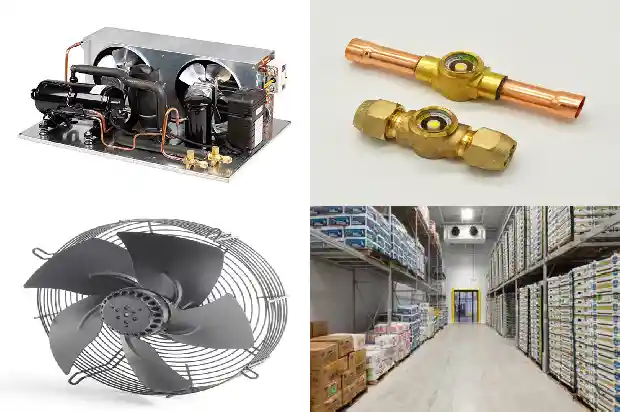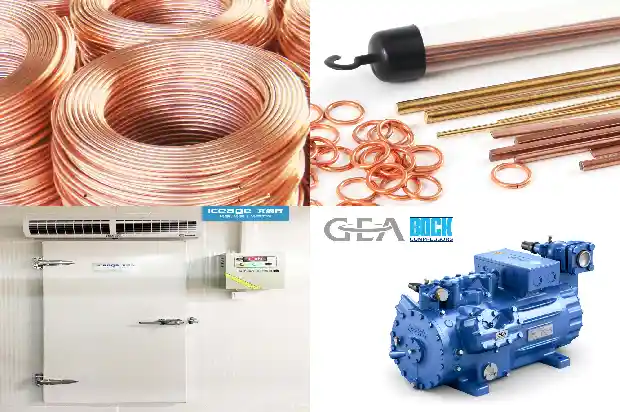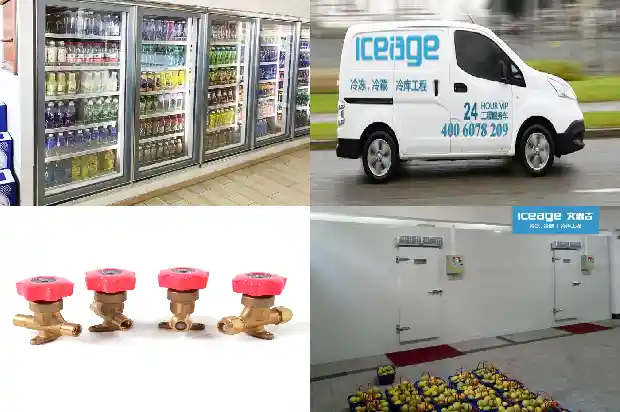Where Lie the Key Construction Technologies of the Ammonia Refrigeration System?
2025-02-14
I. Installation of Refrigeration Compressor
Before the refrigeration compressor is positioned, clean the soil and dirt at the bottom of the compressor and in the foundation bolt holes, and also clean the surface of the foundation that has passed the inspection. According to the construction drawings and based on the positioning axis of the building, first lay out the longitudinal and transverse centerlines. You can use a marking line to mark the centerline of the equipment. When laying out the lines, place the ruler correctly and stretch it straight, and measure the dimensions accurately.
Positioning of the Refrigeration Compressor: Positioning means moving the compressor from the box base to the equipment foundation after unpacking. Transport the refrigeration compressor and the base to the side of the foundation, align them properly with the foundation, then remove the bolts connecting the refrigeration compressor and the base. Use a crowbar to pry up the other end of the compressor, and place several rollers between the compressor and the base. Let the compressor fall onto the rollers. Then, place three or four rollers on the foundation and the base where the lines have been laid. Use a crowbar to pry the refrigeration compressor to make the rollers roll, and horizontally slide the refrigeration compressor from the base to the foundation. Finally, pry up the refrigeration compressor, remove the rollers, and place the shims according to the specific situation.
Alignment of the Refrigeration Compressor: Alignment means positioning the compressor to the specified position so that the longitudinal and transverse centerlines of the refrigeration compressor are aligned with the centerlines on the foundation.
Initial Levelling of the Refrigeration Compressor: Initial levelling is to adjust the levelness of the refrigeration compressor to be close to the requirement after positioning and alignment. The grouting of the anchor bolts of the refrigeration compressor is carried out, and then fine - levelling is done after cleaning.
Fine - levelling of the Equipment and Foundation Plastering: For the secondary grouting of the anchor bolt holes, after the initial levelling of the refrigeration compressor, the anchor bolt holes can be grouted for the second time. The grouting uses fine - aggregate concrete and cement mortar, and its strength grade is at least one grade higher than that of the foundation. To make the anchor bolts and the foundation form an integral part after grouting, keep the foundation holes clean before grouting. Oil stains, dirt, and other debris must be cleaned thoroughly. The concrete in each hole must be poured at one time. After grouting, sprinkle water for curing, and the curing time should be no less than 7 days. The anchor bolts can be tightened only when the concrete has cured to reach 70% of its strength.
II. Installation of Oil - Ammonia Separator
It is installed behind the compressor and functions to separate vapor and liquid, and can also separate lubricating oil. During installation, the normal liquid level should be 0.5 - 2.0mm higher than the normal liquid level in the evaporator to ensure the normal liquid supply to the evaporator by means of the static pressure of the liquid.
III.

It is installed behind the oil separator and the low - pressure liquid storage tank to collect the returned oil. When installing the oil collector, the area around the oil discharge pipe should be spacious to prevent accidents caused by the difficulty of timely handling of the ammonia liquid carried out during oil discharge. When the pressure - reducing pipe of the oil collector is connected to the return vapor pipe, it should be slightly far from the suction port of the refrigeration compressor to avoid the wet stroke of the compressor when the refrigerant in the pressure - reduced and recovered oil is recycled.

IV. Installation of Condenser
- The foundation elevation should meet the requirements of the design, and the allowable error is ±20mm. The connection or fixation between the anchor bolts of the cooling tower and the embedded parts should be firm. All connecting parts should use hot - dip galvanized or stainless - steel bolts, and their fastening force should be consistent and uniform.
- The cooling tower should be installed horizontally.
The allowable deviation of the levelness and perpendicularity of a single cooling tower installation is 2/1000. When multiple cooling towers in the same cooling water system are installed, the water surface heights of each cooling tower should be the same, and the height difference should not be greater than 30mm.
- The direction and position of the water outlet and nozzles of the cooling tower should be correct. The water - collecting tray should be tight and free of leakage.
The water distributor should distribute water evenly. For the cooling tower with a rotating water distributor, its rotating part should be flexible, and the direction of the water spray outlet should be consistent according to the design or product requirements.
- The radial clearance between the end of the cooling tower fan blade and the perimeter of the tower body should be uniform. For the blades with adjustable angles, the angles should be the same.
Related Articles
- What Issues Should Be Noted in Cold Storage Installation and Construction?
- Conditions are Required for the Construction of Small - sized Cold Storages
- What Benefits Does Cold Storage Construction Bring to People in Life?
- Introduction to the Construction and Features of Cold Storage in Cold Chain Logistics
- Myths about "condensate water" in HVAC construction. Know more
- How to prevent vibration and reduce noise in the installation and construction of cold storages?
- Common Issues to Pay Attention to During Cold Room Installation and Construction
- How to Properly Extract Ammonia Refrigerant during Refrigeration Parts Repair
- Which is Better: Ammonia Refrigeration or Fluorine Refrigeration?
- Cooling Operation of Ammonia Refrigerated Cold Storage
- Scheme for the Use and Safety of Ammonia Refrigerants
- Safety Regulations for Ammonia Refrigeration Machine Room
- Cost Comparison of Ammonia-to-Fluorine Conversion in Cold Storage Renovation
- What is the difference between ammonia refrigeration and fluorine refrigeration?
- Have You Encountered the Three Common Problems of Refrigeration Compressors?
- How to Calculate Refrigeration Load? And What Are the Issues?
- What to Do if the Compressor of a Frozen and Refrigerated Display Cabinet Runs but the Refrigeration Effect Is Poor?
- Instructions for Welding and Drainage in the Installation of Refrigeration Equipment Pipelines
